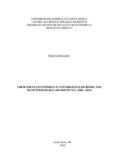| dc.creator | Battistella, Priscila | |
| dc.date.accessioned | 2018-09-14T21:03:06Z | |
| dc.date.available | 2018-09-14T21:03:06Z | |
| dc.date.issued | 2017-06-30 | |
| dc.identifier.uri | http://repositorio.ufsm.br/handle/1/14314 | |
| dc.description.abstract | Accessibility to credit is an important element for economic development in rural areas, since it provides resources for production, marketing and investment costs, making it possible to increase productivity through the use of inputs and facilitating access to machines and equipment. The literature deals with the correlation between credit and economic growth, but the question about its effects of development still requires studies, especially in rural areas. In this way, this dissertation seeks to deepen the knowledge about the concentration of rural credit, subdivided in purposes (agricultural and livestock) in 489 municipalities of Rio Grande do Sul and verify if there is any relationship with the Rural Development Index (IDR) in the period of 2005 To 2010. The methodology of this work is subdivided into three items, where the first one is developed the Herfindahl-Hirschmann Index (IHH), the second item reveals information about the Rural Development Index (IDR) in the state and the third presents the model Used to evaluate the relationship between rural development and credit used by the agricultural sector. This dissertation concludes that there is a concentration of credit at the beginning of the analysis period and that there is an improvement in the distribution of rural credit in the following years, also shows that in 2010, there is a high percentage concentration of rural credit in the western and southern regions of the state, Where there is a predominance of livestock. In the regions to the East and North there is a greater predominance of agricultural crops and concentration of IHH, is relatively less concentrated. The suggestion of an example of a rural development measure, such as a Rural Development Index (RDI) for different regions of the state of Rio Grande do Sul, concluded that the current rural development scenario is a result of economic processes, and by identifying more Understand the dimensions and why inequalities exist or continue, a channel of communication can be established with the proposals of new public policies that have the reduction of regional inequalities of development as the main incentive. Therefore, it can be stated that, in general, rural livestock and agricultural credit influence the State Rural Development Index, and if the rural credit of the period in question increases / decreases by 1%, the state IDR would suffer a positive / negative impact of 0.0004 point. | eng |
| dc.language | por | por |
| dc.publisher | Universidade Federal de Santa Maria | por |
| dc.rights | Attribution-NonCommercial-NoDerivatives 4.0 International | * |
| dc.rights.uri | http://creativecommons.org/licenses/by-nc-nd/4.0/ | * |
| dc.subject | Índice de desenvolvimento rural | por |
| dc.subject | Crédito rural | por |
| dc.subject | Rio Grande do Sul | por |
| dc.subject | Index of rural development | eng |
| dc.subject | Rural credit | eng |
| dc.title | Crédito e desenvolvimento rural no Rio Grande do Sul (2005-2010) | por |
| dc.title.alternative | Credit and rural development in Rio Grande do Sul (2005-2010) | eng |
| dc.type | Dissertação | por |
| dc.description.resumo | A acessibilidade ao crédito é um elemento relevante para o desenvolvimento econômico no meio rural, uma vez que assegura recursos para custeio da produção, comercialização e investimento, viabilizando o aumento da produtividade por meio da utilização de insumos e facilitando o acesso a máquinas e equipamentos. A literatura trata da correlação entre crédito e crescimento econômico, mas o efeito do crédito no desenvolvimento ainda demanda estudos, especialmente no meio rural. O objetivo da pesquisa é analisar a evolução e a concentração de crédito no setor agropecuário dos municípios do Rio Grande do Sul no período de 2005 a 2010 e a sua relação com o Índice de Desenvolvimento Rural de 2010. A metodologia está subdividida em três itens: no primeiro é apresentado o Índice de Herfindahl-Hirschmann (IHH), utilizado para medir a concentração do crédito rural no Rio Grande do Sul; o segundo traz informações sobre o Índice de Desenvolvimento Rural (IDR), que indica o grau de desenvolvimento rural nos municípios do Estado; e o terceiro apresenta o modelo econométrico utilizado para avaliar a relação entre o Índice de Desenvolvimento Rural (IDR) e o crédito utilizado pelo setor agropecuário. Conclui-se que a agricultura utiliza mais crédito do que a pecuária, e que entre as modalidades a mais utilizada é o crédito de custeio. No período analisado, a concentração do crédito vem caindo e ele está mais concentrado nas regiões Oeste e Sul do Estado, onde os municípios tem maior área e predomina a pecuária. Nas regiões Leste e Norte há um predomínio maior de culturas agrícolas e a concentração é relativamente menor. Sobre a relação crédito rural e desenvolvimento, captada através do Índice de Desenvolvimento Rural (IDR), constatou-se, de modo geral, que o crédito rural pecuário e agrícola tem relação positiva com o IDR do Estado, sendo que, se o crédito rural do período em questão aumenta/diminui em 1%, o IDR é impactado positivamente/negativamente em 0,0004 ponto. | por |
| dc.contributor.advisor1 | Marion Filho, Pascoal José | |
| dc.contributor.advisor1Lattes | http://lattes.cnpq.br/6357528016447284 | por |
| dc.contributor.referee1 | Denardin, Anderson Antonio | |
| dc.contributor.referee1Lattes | http://lattes.cnpq.br/8520458665069378 | por |
| dc.contributor.referee2 | Zilli, Julcemar Bruno | |
| dc.contributor.referee2Lattes | http://lattes.cnpq.br/0711121596112027 | por |
| dc.creator.Lattes | http://lattes.cnpq.br/5964204397314045 | por |
| dc.publisher.country | Brasil | por |
| dc.publisher.department | Economia | por |
| dc.publisher.initials | UFSM | por |
| dc.publisher.program | Programa de Pós-Graduação em Economia e Desenvolvimento | por |
| dc.subject.cnpq | CNPQ::CIENCIAS SOCIAIS APLICADAS::ECONOMIA | por |
| dc.publisher.unidade | Centro de Ciências Sociais e Humanas | por |



